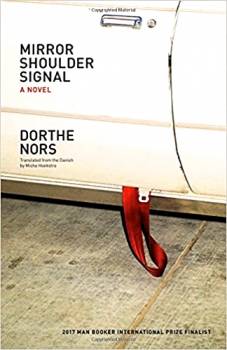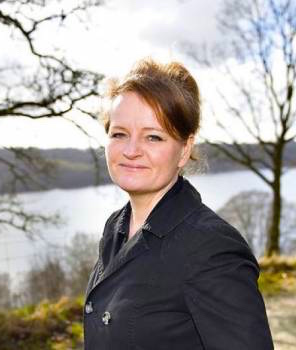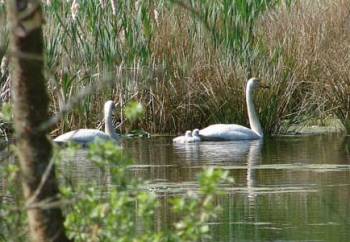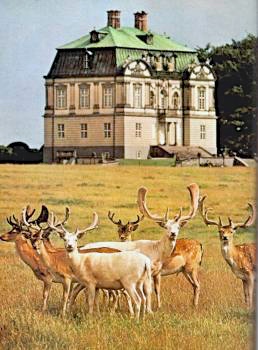Note: This novel was SHORTLISTED for the Man Booker International Prize in 2017.
“Folke places his hand over hers. Sonja can now feel both the gearstick and Folke’s hand. Then he begins to move their stacked hands: the gearstick is activated. ‘You have to imagine an H with two segments poking out of the middle, and then we do like this…You cannot make diagonal movements with the stick,’ Folke explains. ‘You can not go from second to third by taking a shortcut…Now we’ll try it in real life.’ Mirror Shoulder, Signal: Sonja tries to use her body, but the car’s too big.”
 In this surprising, unusual, and often wickedly ironic novel by Danish author Dorthe Nors, the main character’s struggle to master driving a car with a stick shift, becomes a symbol of her life, or as much of a life as she has managed to create for herself. Forty-one-year-old Sonja gets most of her excitement second-hand from her work translating into Danish the novels of Gosta Svensson, one of the most popular thriller writers throughout Scandinavia – novels of crime, criminals, rapists, murderers, and evil doers. Sonja, who grew up in Jutland, became the first person in her family to graduate from college and leave the farm, but in many ways she has never really left. Gone from Jutland for almost two decades and now out of touch with many people from her past, including her sister, she is a woman in Copenhagen now, still single, still unable to drive, still working in a job in which she has almost no contact with other professionals, and still too reserved and withdrawn to make many friends, though she sometimes tries.
In this surprising, unusual, and often wickedly ironic novel by Danish author Dorthe Nors, the main character’s struggle to master driving a car with a stick shift, becomes a symbol of her life, or as much of a life as she has managed to create for herself. Forty-one-year-old Sonja gets most of her excitement second-hand from her work translating into Danish the novels of Gosta Svensson, one of the most popular thriller writers throughout Scandinavia – novels of crime, criminals, rapists, murderers, and evil doers. Sonja, who grew up in Jutland, became the first person in her family to graduate from college and leave the farm, but in many ways she has never really left. Gone from Jutland for almost two decades and now out of touch with many people from her past, including her sister, she is a woman in Copenhagen now, still single, still unable to drive, still working in a job in which she has almost no contact with other professionals, and still too reserved and withdrawn to make many friends, though she sometimes tries.
During one of her early driving lessons, for example, the road passes Copenhagen’s Western Cemetery, a place she knows well, and she reaches out to the driving instructor, commenting, “You know I really like Western Cemetery. Down in the bottom part is a chapel with plywood over the window. I think they’ve stopped using it. There’s this avenue of gnarled old poplars there, too. And a pond. I love to take a blanket and lie there and read.” The aggressive female instructor reacts to this overture by ignoring it and getting into a shouting match with other drivers at a traffic light, complete with middle finger gestures which create chaos. In the midst of all this, Sonja, however, continues to muse about how “lovely” it is to go the cemetery and think about the dead prime ministers there, listen to the ducks, see the sun gleam off the roof of the big chapel and experience “the scent of yew and boxwood; almost the middle of nowhere. A stag might drift past, and she’s bought a cookie for her coffee…The dead make no noise and if she’s lucky a bird of prey might soar overhead. Then she’ll lie there, and escape.”
This contrast between real life in the outside world and Sonja’s life, most of which is her inner life of imagination (or her lack of it) persists throughout the novel, allowing author Dorthe Nors to entice the reader into drawing his/her own conclusions about all the characters as they respond to what is happening and to draw conclusions about Sonja, who never really sees herself as others see her. As Sonja imagines herself reaching out, as much out of boredom as timidity, the reader also comes to conclusions about how she behaves, whether she is succeeding, whether she is forming any long-term goals, and if she is connecting with others. Author Nors is clever with the way she compresses her writing and stays out of the picture here. She makes no clichéd commentary, pruning her details and observations into scenes which force the reader to fill in blanks. Some readers may become frustrated at the time it takes Sonja, a basically boring main character, to become more interesting, but as blanks get filled in and the novel develops, a reader cannot help but become intrigued by some of the subtle ironies and clever touches which make the novel fun and often very funny.
In one early scene, for example, Sonja has an appointment with Ellen, her masseuse, who “is working on her butt” to persuade Sonja’s body to let the anger come out her mouth. While Ellen is working, Sonja herself is looking around, noticing that Ellen has left knitting on her kitchen counter. “Your buttocks are hard,” Ellen observes. “That’s because, if you’ll pardon a vulgar phrase, you’re a tight-ass with your feelings.” As she works, Ellen recommends confrontation for solving Sonja’s problems, especially with Jytte, the aggressive woman at the driving school. “As a massage therapist, Ellen sees it as her job to decode Sonja, and Sonja’s only countermove is to decode Ellen,” something that does not happen in this scene in which Sonja, during the massage, is thinking about her sister and brother-in-law and her friend Molly, whose interest lies in the supernatural; about a former boyfriend; and about going to the Jaegersborg Deer Park on Sunday. Relaxation techniques and putting herself into the hands of Ellen are clearly not working as Ellen hopes they will, though Sonja enjoys the experience as much as she can enjoy anything over which she has little control. Cosmic forces, a fortune teller, and ghosts also catch Sonja’s attention at other moments in the novel as she tries to understand her world.

When she was a child, Sonja took a school trip to Lake Jul, where she and her class rode in the Hjejlen paddleboat. She later bought a snowglobe of this as a souvenir.
Throughout the novel, Nors maintains the contrasts between life in Copenhagen and life in Jutland, primarily by showing Sonja and her relationship with her sister Kate, who is not only in a very different part of the country, and in a different relationship with her world, but is also very different in personality. Occasionally, Sonja will write a card or a letter to Kate, but she never mails it, and the two have little contact, increasing the sense of anticipation within the novel and adding to its effect as details unfold. Sonja’s reminiscences about Jutland, which she knows has changed dramatically, especially for farmers, also act as a visual foil for the settings in Copenhagen, helping the reader to see why Sonja is so conflicted – and sometimes bored. Both geographical areas – Jutland and Copenhagen – are described in ways which will make the reader long to visit the country for its natural beauty, a tribute to Nors’s descriptive skills and her obvious interest in nature. An unsuitable man who may be contemplating a flirtation with Sonja appears as the novel winds down, and a close reading of that relationship leads the reader to understand Sonja in a new way. The satisfying conclusion brings together all the loose ends and images which repeat throughout the novel, even including one unusual image of a brown sugar sandwich. In this short novel about people, relationships, and what we regard as home, author Dorthe Nors accomplishes wonders.
ALSO by Dorthe Nors: KARATE CHOP (Stories)
Photos. The author’s photo, by Henning Bagger, appears on https://www.kristeligt-dagblad.dk/
The whooper swans are one of Sonja’s memories of childhood, and she is pleased that they are still living on the heath, despite the changes in Jutland since she left. Photo by Niels Peter Brogger. https://www.dof.dk
Sonja and Ellen decide to go to the Jaegersborg Deer Park on the weekend after her massage. https://www.pinterest.com/
Sonja recalls a trip she took with her school class at the age of twelve to Lake Jul, where the rode on the paddleboat. Later she bought a snow globe of it to remember the trip. http://en.hjejlen.com/



